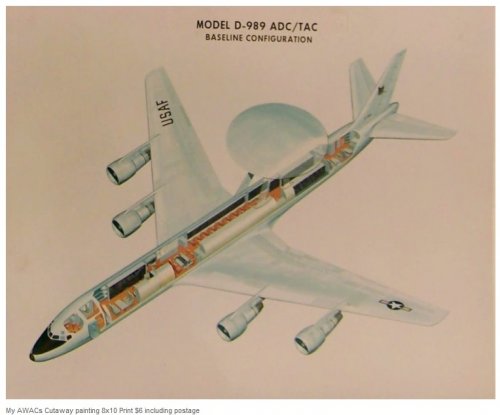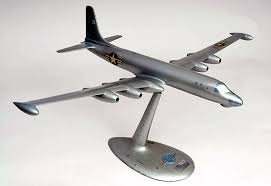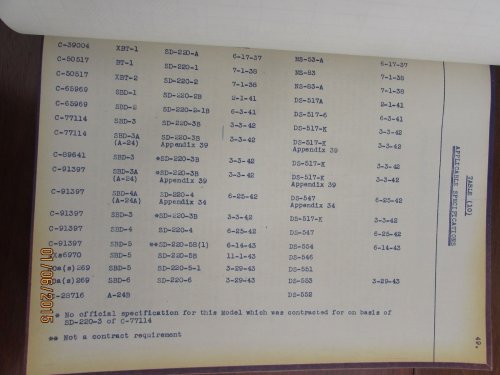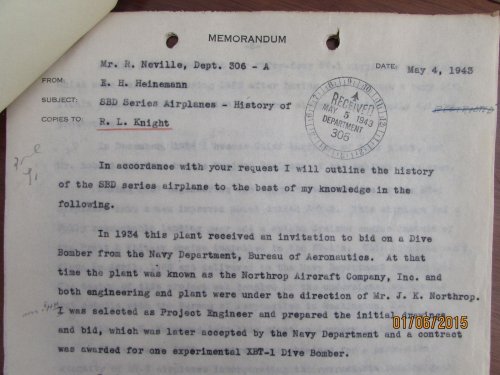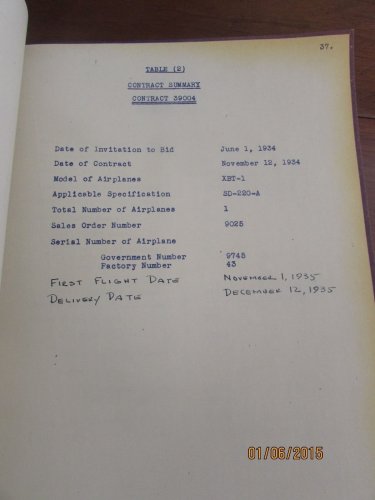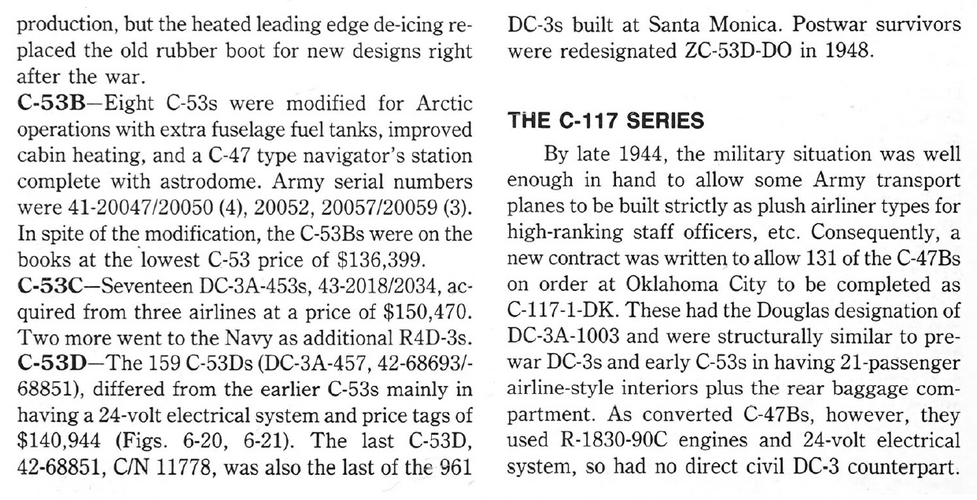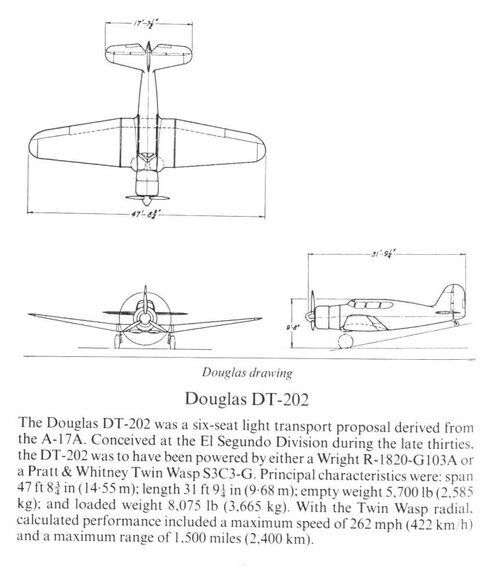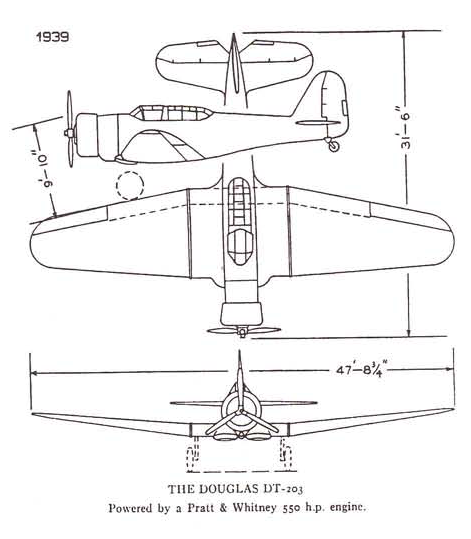You are using an out of date browser. It may not display this or other websites correctly.
You should upgrade or use an alternative browser.
You should upgrade or use an alternative browser.
Douglas Designations
- Thread starter Maveric
- Start date
- Joined
- 25 June 2009
- Messages
- 14,731
- Reaction score
- 6,069
hesham said:I want to understand,why many different prefix and what was the differences between them, D,DS,SS & TS ?.
If I'm not mistaken, D- was for Design, DS- for Detail Specification, TS- for Type Specification and SS- for System Specification.
Last edited:
- Joined
- 26 May 2006
- Messages
- 34,823
- Reaction score
- 15,699
Skyblazer said:hesham said:I want to understand,why many different prefix and what was the differences between them, D,DS,SS & TS ?.
If I'm not mistaken, D- was for Design, DS- for Design Specification, TS- for Type Specification and SS- for System Specification.
Thank you my dear Skyblazer.
- Joined
- 12 July 2006
- Messages
- 947
- Reaction score
- 737
Attachments
- Joined
- 26 May 2006
- Messages
- 34,823
- Reaction score
- 15,699
boxkite said:Douglas D-989
Source: http://beigleart.com/aviation-artwork-memorabilia/
Nice find my dear Boxkite.
- Joined
- 19 February 2007
- Messages
- 1,434
- Reaction score
- 2,668
The compound designation DC-3B-202 looks to be valid. This appears to be a mashup of the Commercial Product Name of DC-3B and the controlling Specification which is DS-202 (specifically Detail Specifications number 202 and 202A which defined the configurations of 8 "DSTs" and 2 "DC-3's" respectively for TWA). By the way, these had "-G102" engines.
-----
If one were to use this method (name-specification) for DC-4-507 and -537, we end up with a nonsensical interpretation since the DC-4 is wholly a Douglas Santa Monica product and Specification Numbers 507 and 537 are in the Douglas El Segundo range and are applied to a DB-7B configuration (controlled by DS-508) and a 24 passenger variant of the DC-5 (controlled by TS-534).
Note that a Detail Specification (DS) and a Type Specification (TS) differ in the level of detail in description - the TS is generally a high level document and less detailed. The DS tends to invoke the TS as a source (high level specification) and then controls the the configuration of the aircraft from a specific customer order and in particular, those options (engines, avionics, passenger layout, etc) selected.
I'm not saying that these numbers are wrong - they may refer to yet another internal numbering series for which we have little insight. Or they could just plain wrong or confused. Douglas internals are quite confusing to reconstruct, particularly without recourse to the the original "Command Media" that established them.
Clear as mud?
-----
If one were to use this method (name-specification) for DC-4-507 and -537, we end up with a nonsensical interpretation since the DC-4 is wholly a Douglas Santa Monica product and Specification Numbers 507 and 537 are in the Douglas El Segundo range and are applied to a DB-7B configuration (controlled by DS-508) and a 24 passenger variant of the DC-5 (controlled by TS-534).
Note that a Detail Specification (DS) and a Type Specification (TS) differ in the level of detail in description - the TS is generally a high level document and less detailed. The DS tends to invoke the TS as a source (high level specification) and then controls the the configuration of the aircraft from a specific customer order and in particular, those options (engines, avionics, passenger layout, etc) selected.
I'm not saying that these numbers are wrong - they may refer to yet another internal numbering series for which we have little insight. Or they could just plain wrong or confused. Douglas internals are quite confusing to reconstruct, particularly without recourse to the the original "Command Media" that established them.
Clear as mud?
Hi All!
Hi aim9xray, you can prove this data--- DS-202 (specifically Detail Specifications number 202 and 202A which defined the configurations of 8 "DSTs" and 2 "DC-3's" respectively for TWA)---documented ?
R-1820-G202--these engines have been on DC-3B.
If you can send these documents.
I know that Douglas Model 202---6 seat derivative of A-17 (named DT-202).
Hi aim9xray, you can prove this data--- DS-202 (specifically Detail Specifications number 202 and 202A which defined the configurations of 8 "DSTs" and 2 "DC-3's" respectively for TWA)---documented ?
R-1820-G202--these engines have been on DC-3B.
If you can send these documents.
I know that Douglas Model 202---6 seat derivative of A-17 (named DT-202).
- Joined
- 19 February 2007
- Messages
- 1,434
- Reaction score
- 2,668
I strongly suspect that I am working from a copy of the same document as referenced in Stargazer's post earlier upthread.
As to 'DT-202' - as you may have guessed, this is from the El Segundo Division. They apparently named a small number of their designs in the 'DT-2xx' series - which had nothing to do with the 'DS' specification series. This is because the El Segundo Division was the renamed former Northrop Corporation (of which Douglas had the controlling interest, and eventually bought out Jack Northrop in 1939).
Legacy designs from that era retained their use of NS documents (Northrop Specification) well into the Douglas era (there being no real reason to retroactively change the documentation). There was an auction on eBay of a Douglas booklet detailing the history of the SBD - the SBD-1 being built to a NS spec; later SBD versions were built to DS spec numbers. (I'd post that if I could find it).
When the former Northrop operation was fully absorbed by Douglas, the decision was apparently made to allocate a block of prospective Specification numbers to the new El Segundo Division (these being from 500 to 999) so that El Segundo and Santa Monica would not 'step on each other". (This is why spec 499 - last of the 'first Santa Monica series' - has a much later issue date than spec 500 - the first of the El Segundo Division series.) Drawing numbers and report numbers were similarly issued in alternating blocks.
When Santa Monica hit number 499, they jumped to 1000 as their next number and proceeded onward. The 15xx, 16xx, and 17xx blocks appear to have been reserved for as yet unknown uses. Santa Monica specifications (generally for aircraft) then picked up at 18xx in late 1952 or early 1953 and then continued into the early 1960s. Things even more confusing at that point as the El Segundo Division was closed and aircraft manufacturing ended at Santa Monica; with design activities being moved to and concentrated at the Long Beach Division. There appear to have been several distinct advanced design groups active at Long Beach, using the heritage numbering series from their previous organizations. Thus, in the late 1960s, you have DC-8 AWACS studies being done under 98x numbers while DC-8 airliners are being built under 29xx and 3xxx DTS specification numbers.
Still clear as mud?
As to 'DT-202' - as you may have guessed, this is from the El Segundo Division. They apparently named a small number of their designs in the 'DT-2xx' series - which had nothing to do with the 'DS' specification series. This is because the El Segundo Division was the renamed former Northrop Corporation (of which Douglas had the controlling interest, and eventually bought out Jack Northrop in 1939).
Legacy designs from that era retained their use of NS documents (Northrop Specification) well into the Douglas era (there being no real reason to retroactively change the documentation). There was an auction on eBay of a Douglas booklet detailing the history of the SBD - the SBD-1 being built to a NS spec; later SBD versions were built to DS spec numbers. (I'd post that if I could find it).
When the former Northrop operation was fully absorbed by Douglas, the decision was apparently made to allocate a block of prospective Specification numbers to the new El Segundo Division (these being from 500 to 999) so that El Segundo and Santa Monica would not 'step on each other". (This is why spec 499 - last of the 'first Santa Monica series' - has a much later issue date than spec 500 - the first of the El Segundo Division series.) Drawing numbers and report numbers were similarly issued in alternating blocks.
When Santa Monica hit number 499, they jumped to 1000 as their next number and proceeded onward. The 15xx, 16xx, and 17xx blocks appear to have been reserved for as yet unknown uses. Santa Monica specifications (generally for aircraft) then picked up at 18xx in late 1952 or early 1953 and then continued into the early 1960s. Things even more confusing at that point as the El Segundo Division was closed and aircraft manufacturing ended at Santa Monica; with design activities being moved to and concentrated at the Long Beach Division. There appear to have been several distinct advanced design groups active at Long Beach, using the heritage numbering series from their previous organizations. Thus, in the late 1960s, you have DC-8 AWACS studies being done under 98x numbers while DC-8 airliners are being built under 29xx and 3xxx DTS specification numbers.
Still clear as mud?
- Joined
- 26 May 2006
- Messages
- 34,823
- Reaction score
- 15,699
I want to understand,why many different prefix and what was the differences
between them, D,DS,SS & TS ?.
Hi Aim9xray,
can you explain why those designation systems appeared ?.
Vahe Demirjian
I really should change my personal text
- Joined
- 28 February 2013
- Messages
- 815
- Reaction score
- 570
Does anyone have drawings or other illustrations of the Douglas D-856 design?
Last edited:
- Joined
- 26 May 2006
- Messages
- 34,823
- Reaction score
- 15,699
Does anyone have drawings or other illustrations of the Douglas D-856 design, given that the number of engines suggests a giant bomber design?
Sorry,my mistake,I meant this,a Model-1856.
Attachments
- Joined
- 19 February 2007
- Messages
- 1,434
- Reaction score
- 2,668
No. The six-jet bomber is the Model 1155. (The model was on the wrong base.) The Model 1856 is the Jet Tanker Transport from the year 1955; visually, almost but not quite, a DC-8. Both of these Douglas Santa Monica designs are searchable on SPF. The Model D-856 was an El Segundo design.Sorry,my mistake,I meant this,a Model-1856.
- Joined
- 19 February 2007
- Messages
- 1,434
- Reaction score
- 2,668
Of interest is this page from Douglas report ES-6592 on the history of the Navy SBD (the ES meaning that the report was issued by the El Segundo Division). The report was on eBay, alas, I did not win it. Nonetheless, some interesting pages were shown. Let's walk through this particular one...
The first column appears to be the Navy contract number.
Second: Navy or Army designation*
Third: Navy specification number
Fourth: Navy Specification issue date
Fifth: Company specification number Northrop (and later, Douglas)**
Sixth: Company specification issue date
*Note the designation change after the Douglas takeover and renaming of the former Northrop company
** Note the specification numbering change after the Douglas takeover. "NS" is believed to be "Northrop Specification" as it would later be used in the later Northrop Aircraft Inc (now Northrop Grumman). "DS" appears to mean "Detail Specification" in Douglas usage.
Edit: Attached cover letter and summary of the first contract showing the dates of the original effort.
The first column appears to be the Navy contract number.
Second: Navy or Army designation*
Third: Navy specification number
Fourth: Navy Specification issue date
Fifth: Company specification number Northrop (and later, Douglas)**
Sixth: Company specification issue date
*Note the designation change after the Douglas takeover and renaming of the former Northrop company
** Note the specification numbering change after the Douglas takeover. "NS" is believed to be "Northrop Specification" as it would later be used in the later Northrop Aircraft Inc (now Northrop Grumman). "DS" appears to mean "Detail Specification" in Douglas usage.
Edit: Attached cover letter and summary of the first contract showing the dates of the original effort.
Attachments
Last edited:
Vahe Demirjian
I really should change my personal text
- Joined
- 28 February 2013
- Messages
- 815
- Reaction score
- 570
Does anyone have pics or specs for the D-856 bomber design envisaged by the El Segundo Division of Douglas in the 1960s?
- Joined
- 19 February 2007
- Messages
- 1,434
- Reaction score
- 2,668
Unfortunately, you've been confused by a post or two by another forum member who was conflating the Model 1856 and Model D-856. The Model D-856 was a V/STOL aircraft of some sort, not a bomber.Does anyone have pics or specs for the D-856 bomber design envisaged by the El Segundo Division of Douglas in the 1960s?
- Joined
- 26 May 2006
- Messages
- 34,823
- Reaction score
- 15,699
Unfortunately, you've been confused by a post or two by another forum member who was conflating the Model 1856 and Model D-856. The Model D-856 was a V/STOL aircraft of some sort, not a bomber.
Dear Aim9xray,
do you have a complete list to or any unknown designations never mentioned in this thread ?,and thanks.
- Joined
- 19 February 2007
- Messages
- 1,434
- Reaction score
- 2,668
I do not believe that a complete 'company-generated' list exists. If it did, I would be wary of it because it would have to have been compiled in the relative recent past (in order to be complete), and I doubt that someone in today's business-oriented configuration/data management organizations would have the insight, patience and resources to research, understand and reconcile the inconsistencies that have occurred as generations of engineers and clerks have added to the list and subtly changed meanings, usages, conventions and definitions.
- Joined
- 26 May 2006
- Messages
- 34,823
- Reaction score
- 15,699
A reference in a document, hand copied as a note, some time ago.
OK dear Aim9xray,
please,can you tell us some Douglas's designations we don't know it,and never mentioned in this thread,and thanks ?.
- Joined
- 26 May 2006
- Messages
- 34,823
- Reaction score
- 15,699
Hi,
I suggest that for Dougals designation lists,he had some different sequences,no logical if we
see Model-1858 and Model-1155 were from 1950s,so I guess only for this system;
- "D" was used from early Douglas company appearance in 1920s,used up to 1967
- "Model" was used from 1945 and began with number "1000",used up to 1967
- "DS,SS,TS & GS" this was a Santa Monica drawings maybe,began from 1940, and continued up
to 1950,maybe for drawings or unbuilt Projects ?
- "DS,TS & SS" was the second used for this designation numbers,began as I expected by number
"1500" and from 1950 to 1967,sometimes had wrong reference as Model,but in fact it was a
drawings numbered,used for built or unbuilt aircraft
Please note that,from 1967 and after amalgamated with McDonnell,there was two important things
happened;
- the later series which began from number "1500" continued with new company to the end of
its life,but used the prefix "D" only
- after merged,the MD firm used the Model series "900" again,and up to maybe 1000 or more ?
My dears and my friends,its only my speculations,and any corrections or additions are welcome
I suggest that for Dougals designation lists,he had some different sequences,no logical if we
see Model-1858 and Model-1155 were from 1950s,so I guess only for this system;
- "D" was used from early Douglas company appearance in 1920s,used up to 1967
- "Model" was used from 1945 and began with number "1000",used up to 1967
- "DS,SS,TS & GS" this was a Santa Monica drawings maybe,began from 1940, and continued up
to 1950,maybe for drawings or unbuilt Projects ?
- "DS,TS & SS" was the second used for this designation numbers,began as I expected by number
"1500" and from 1950 to 1967,sometimes had wrong reference as Model,but in fact it was a
drawings numbered,used for built or unbuilt aircraft
Please note that,from 1967 and after amalgamated with McDonnell,there was two important things
happened;
- the later series which began from number "1500" continued with new company to the end of
its life,but used the prefix "D" only
- after merged,the MD firm used the Model series "900" again,and up to maybe 1000 or more ?
My dears and my friends,its only my speculations,and any corrections or additions are welcome
- Joined
- 26 May 2006
- Messages
- 34,823
- Reaction score
- 15,699
- "D" was used from early Douglas company appearance in 1920s,used up to 1967
- "Model" was used from 1945 and began with number "1000",used up to 1967
- "DS,SS,TS & GS" this was a Santa Monica drawings maybe,began from 1940, and continued up
to 1950,maybe for drawings or unbuilt Projects ?
- "DS,TS & SS" was the second used for this designation numbers,began as I expected by number
"1500" and from 1950 to 1967,sometimes had wrong reference as Model,but in fact it was a
drawings numbered,used for built or unbuilt aircraft
Please note that,from 1967 and after amalgamated with McDonnell,there was two important things
happened;
- the later series which began from number "1500" continued with new company to the end of
its life,but used the prefix "D" only
- after merged,the MD firm used the Model series "900" again,and up to maybe 1000 or more ?
After some reviews,the DS,SS,TS & GS which was started at 1940,continued up to year 1967 also,
we see in the late of 1950s and early 1960s,a numbers 15xx beside 2xxx and in the same time,and
that's only my suggesting,also the logical solution for this dilemma.
Were it came from I do not know, but the c/n 422 to 430 were not intended for British Airways.Some addition to this listing:
1. C/n 422 to 430 were originally ordered by Britain with registrations G-AFYG to G-AFYO.
2. the 1941 serials were applied locally in Australia and are not formally part of the USAAF serial listings. Then, sometime in 1944 the USAAF in Australia decided to send a 'write off note', or something similar to (I would presume) the Pentagon where somebody probably said "oh sh**, we cannot write these off without having them entered into the books" so the three aircraft were serialled 44-83230 (c/n 428), 44-83231 (c/n 424) and 44-83232 (c/n 426) and were probably written off on the same day.
3. c/n 426 eventually ended up in Israel.
Much of this info comes from the work by a John Hopton that I received in hard copy some ten years ago (far too much to scan, so please do not ask!). If there is interest I could, however, extract relevant data from Hopton's detailed lists for these aircraft and make that available through here.
In my research for the DC-5 I visited the British Airways Heritage collection.
There documents made it clear that along side the mentioned construction numbers, aircraft were intended for British Airways to be delivered after the mentioned construction numbers. The first batch of DC-5's was never intended to go to British Airways.
Vahe Demirjian
I really should change my personal text
- Joined
- 28 February 2013
- Messages
- 815
- Reaction score
- 570
Do you have a photo of that document reference? Are there any available drawings of the D-856?A reference in a document, hand copied as a note, some time ago.
- Joined
- 19 February 2007
- Messages
- 1,434
- Reaction score
- 2,668
Well, if I had a photo of that document reference, I would not had hand-copied that designation as a note, now would I?Do you have a photo of that document reference? Are there any available drawings of the D-856?A reference in a document, hand copied as a note, some time ago.
The note is:
[Spec] DS-856 | STOL Airplane Studies - Ducted Propeller | [Model] D856 | [Date Spec Assigned] 5-14-62 | [Requestor] AD, [illegible name] - assume AD is Advanced Design?
As to drawings - no I have not seen any.
In a letter from the NLL to KLM, dated 22 Februari 1943, the model DC-4-156 is mentioned.
It handels about a document "Sketches and Schematic Diagrams of the Systems in the Douglas experimental model DC-4 Airplane".
It handels about a document "Sketches and Schematic Diagrams of the Systems in the Douglas experimental model DC-4 Airplane".
Hi all,
I came here looking for a model D-150.
I bought a lot of DWD Jr's papers before he died and this little book titled "Manual of Procedure D-150" was in it. The book was copyright 1942 and it also says "Receiving Inspection" on the front. Since it appears the books were controlled copies (you couldn't take them out of the factory), it seems D-150 is the internal number for the book.
It's actually a pretty interesting book since it contains every one of the vendor stamps in it, and also the Army and Navy stamps. It also describes every single tiny little thing on whatever planes they were making at the time. There are also a lot of company rules: what the different badge colors mean, what buildings they can be in, what various forms are for, which bathrooms to use, etc. It's sort of like an employee manual and a guide to receiving inspections.
I came here looking for a model D-150.
I bought a lot of DWD Jr's papers before he died and this little book titled "Manual of Procedure D-150" was in it. The book was copyright 1942 and it also says "Receiving Inspection" on the front. Since it appears the books were controlled copies (you couldn't take them out of the factory), it seems D-150 is the internal number for the book.
It's actually a pretty interesting book since it contains every one of the vendor stamps in it, and also the Army and Navy stamps. It also describes every single tiny little thing on whatever planes they were making at the time. There are also a lot of company rules: what the different badge colors mean, what buildings they can be in, what various forms are for, which bathrooms to use, etc. It's sort of like an employee manual and a guide to receiving inspections.
- Joined
- 2 January 2011
- Messages
- 345
- Reaction score
- 372
Does anyone have a complete and accurate listing of the Douglas DB-series projects of aircraft?
I have received information that completely contradicts my original documents on several of these, especially the DB-10, which was a TWO-engine project, NOT a FOUR-engine project.
Douglas' Project Spec Numbers for the DB-10 were as follows: DS-271, DS-272 and DS-274. I have original 3-views and engineering analysis documents for this project.
Thanks in advance,
Alan Griffith
I have received information that completely contradicts my original documents on several of these, especially the DB-10, which was a TWO-engine project, NOT a FOUR-engine project.
Douglas' Project Spec Numbers for the DB-10 were as follows: DS-271, DS-272 and DS-274. I have original 3-views and engineering analysis documents for this project.
Thanks in advance,
Alan Griffith
- Joined
- 25 June 2009
- Messages
- 14,731
- Reaction score
- 6,069
Douglas specifications used the DS- prefix (Detail Specification), and sometimes TS- (Type Specification), GS- (General Specification), and even DTS-, which were distinct from Model designations, although the latter sometimes agregated the specification type. Model designations used prefixes corresponding to the type of aircraft, the most obvious being "DB-" for bombers and "DC-" for commercial transports, but other prefixes were also used on occasion.
Early letter designations used without a specification number:
Later letter designations used with specification numbers:
Early letter designations used without a specification number:
- DA for the DA-1 DOUGLAS AMBASSADOR, a parasol wing prototype ordered by Ambassador Airways which crashed on delivery.
- DAM for the DAM-1 DOUGLAS AIR MAIL, the early designation of the M-1 mailplane.
- DAT for the DOUGLAS AERIAL TRANSPORT, whcih became the Army Air Corps's C-1.
- DWC for the DOUGLAS WORLD CRUISER.
- DOS for DOUGLAS OBSERVATION SEAPLANE (USAAC O-5), the former World Cruiser converted.
Later letter designations used with specification numbers:
- DA for DOUGLAS ATTACK, as in DA-209 or Army A-17A, the Second Northrop 8A production batch by Douglas.
- DB for DOUGLAS BOMBER, as in DB-280 for the DIGBY I (RCAF version of the B-18A BOLO) or DB-320 (the B-23 DRAGON).
- DC for DOUGLAS COMMERCIAL, as in DC-1-109 (the DC-1), DC-3A-447 (Pan American) or DC-8-1004 SKYBUS (an unbuilt pusher project).
- DF for DOUGLAS FLYING BOAT, as in DF-151 (Japanese Navy HXD1/2) and DF-195 (Russia N-205/206, the latter crashed in the US upon landing).
- DM for the DOUGLAS MISSILE series, as in DM-1812 for the THOR-ABLE series.
- DO for the DOUGLAS OBSERVATION series as in DO-204, probably related to one of the Army Air Corps's O- series types.
- DST for the DOUGLAS SLEEPER TRANSPORT series as in DST-144 SKYSLEEPER or DST-217, a sleeper transport version of the DC-3.
- DT for DOUGLAS TORPEDO, as in the DT-203 project below.
- DTB for DOUGLAS TORPEDO BOMBER (missing the specification numbers of D-298 and DS-306 but logically should have been DTB-298 and -306).
- DOLPHIN amphibians had no model designation and were directly agregated with the specification numbers (DOLPHIN-113, -119, 136, etc.)
Last edited:
- Joined
- 25 June 2009
- Messages
- 14,731
- Reaction score
- 6,069
After double-checking, and contrary to something I just wrote, I find that both DT-202 and DT-203 existed... which kind of confirms that there must have been TWO distinct numerical sequences, since the number 202 was also used for the DC-3B-202/A (and C-47D/E). I say it "confirms" because I came across several other duplications that seemed to contradict the theory of a single list (another example is DA-209 for the A-17A, while the DC-3-209 was a version for TWA).
Also, it is very clear from the image below and the caption that "DT-" could NOT mean "Douglas Torpedo" AT ALL, as I first thought from looking at the DT-203, since the DT-202 was a transport. A possibility is that the Douglas Commercial types (DC-) used a list that was completely distinct; another possibility is that the El Segundo division used a separate but similar numbering sequence to Long Beach and Santa Monica, and that created problems (hence the skip to 500+).
As to the 500+ series being for El Segundo, it doesn't quite explain the existence of the DC-4-509...
Also, it is very clear from the image below and the caption that "DT-" could NOT mean "Douglas Torpedo" AT ALL, as I first thought from looking at the DT-203, since the DT-202 was a transport. A possibility is that the Douglas Commercial types (DC-) used a list that was completely distinct; another possibility is that the El Segundo division used a separate but similar numbering sequence to Long Beach and Santa Monica, and that created problems (hence the skip to 500+).
As to the 500+ series being for El Segundo, it doesn't quite explain the existence of the DC-4-509...
Attachments
Last edited:
- Joined
- 9 October 2009
- Messages
- 21,928
- Reaction score
- 13,552
- Joined
- 19 February 2007
- Messages
- 1,434
- Reaction score
- 2,668
No.
No.Can this be correct: D.411 for D.C.5?
Similar threads
-
-
-
-
-
Douglas ATA-A1: Another « Skybus » project !
- Started by Stargazer
- Replies: 18

